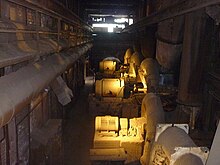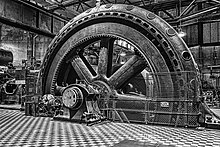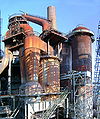Völklinger Hütte
| Völklinger Hütte | |
|---|---|
|
UNESCO world heritage |
|

|
|
| Entrance area of the Völklinger Hütte World Heritage Site |
|
| National territory: |
|
| Type: | Culture |
| Criteria : | (ii), (iv) |
| Reference No .: | 687 |
| UNESCO region : | Europe and North America |
| History of enrollment | |
| Enrollment: | 1994 (session 18) |
Coordinates: 49 ° 15 ′ 2 " N , 6 ° 50 ′ 43" E
The Völklinger Hütte is a former ironworks founded in 1873 in the Saarland city of Völklingen . It was shut down in 1986.
1994 rose UNESCO pig iron production the Völklingen as industrial monument to the rank of world heritage of mankind . In 2007 it was nominated for the award as a historical landmark of civil engineering in Germany . It is a protected cultural asset under the Hague Convention .
The Völklinger Hütte World Heritage Site is now an important location for industrial culture in Europe and the anchor point of the European Route of Industrial Culture (ERIH). It was visited by around 310,000 visitors in 2013.
Geographical location
The hut is located southwest of downtown Völklingen, directly at the Völklingen train station , whose extensive track system was used to transport raw materials to the hut and which is now designed as the “entrance gate”.
history
In 1873, the metallurgical engineer Julius Buch founded a puddling and rolling mill near Völklingen on the Saar . After six years, he had to close his plant because it was no longer profitable for smelting because of the high tariffs on pig iron.
In 1881 there was a new beginning under Carl Röchling . He bought the shutdown facilities and two years later the first blast furnace went into operation. In 1890 the "Röchling'schen Eisen- und Stahlwerke" were the largest iron girder manufacturer in Germany .
A year later, the Thomas steelworks at Völklinger Hütte was opened. The Thomas method was introduced relatively late, but soon showed success. Now the Lorraine minette , an iron ore from the neighboring border region, could also be smelted in Völklingen. Minette was used until 1963.

In order to reach the high temperatures necessary for steel production, besides coal , one needed above all coke . That is why the first coke battery was built right next to the blast furnaces in 1897. The first gas blower went into operation three years later. In 1911 an overhead conveyor system was built to feed the blast furnaces.
On January 16, 1928, the worst accident in the history of the Völklinger Hütte occurred, 13 people died.
When sintering technology arrived in 1928 , one of the most modern and largest sintering plants in Europe was built in Völklingen. It allowed the recycling of waste products such as gout dust and fine ore.
During the Second World War , around 70,000 forced laborers and prisoners of war worked in the mines , smelters and factories of the Saar district. By the end of the war, around 14,000 men and women from the Soviet Union , Poland , Yugoslavia , France , Belgium and Luxembourg , among others , were employed under the most difficult of conditions in the Völklinger Hütte .
In 1952 the smelter reached its production peak due to the construction boom in the post-war period . Only when the Saarland returned to Germany at the end of 1956 did the old owners, the Röchling family of industrialists , get the Völklinger Hütte back.
In 1965, the entire production and administration areas of the Völklinger Hütte had a total of 17,000 employees. The global steel crisis also hit the Völklinger ironworks in 1975. While the Luxembourg steel group Arbed operated the Burbach location in Saarland until 1971, the Völklinger Hütte merged with the “United Hüttenwerke Burbach-Eich-Dudelange” to form “Stahlwerke Röchling-Burbach GmbH”, which was operated jointly with Röchling. With the integration of the Neunkirchen ironworks , Arbed Saarstahl GmbH was created in 1982, from which the Röchling family left (1978). The company has been called Saarstahl since 1986 .
After the pig iron phase was closed in 1986, this part was placed under monument protection as an industrial monument. After continuous repairs and making them accessible, it was used as a museum.
In 1994, UNESCO declared pig iron production at the Völklingen Ironworks a World Heritage Site.
Colloquially, the entire Völklingen factory site of Saarstahl AG is also referred to as the Völklinger Hütte. Today's Völklinger Hütte World Heritage Site covers only a fraction of the approximately 260 hectares of the Völklinger Saarstahl area with a surface area of 7.46 hectares.
World cultural heritage Völklinger Hütte

Cultural events have been taking place on the site of the Völklinger Hütte World Heritage Site since the mid-1990s. The spectrum ranges from open-air rock concerts and chamber music to exhibitions on people, nature and technology.
Franz Zeithammer was initially present as managing director from 1996, whose activities as a tourism multi-manager (including at the Congress Center Saar and the Industrial Culture Foundation) led to an investigation committee and a conviction for infidelity in 1998 .
In July 1999, Saarland founded the supporting company Weltkulturerbe Völklinger Hütte - European Center for Art and Industrial Culture GmbH and appointed the Saarbrücken-born director of the Palatinate History Museum (Speyer), Meinrad Maria Grewenig , as general director and head of the management.
The hut landscape has been illuminated by a light installation by Hans-Peter Kuhn since 1999. In 2001 the nocturnal scenery was expanded to include a light installation by Michael Seyl .
The Ferrodrom , the first science center in the Saar-Lor-Lux area , has been open to visitors since 2004. It is a multimedia world of experience revolving around iron and steel. There are exhibits on the cultural history of iron, iron to touch, films, as well as conversations with contemporary witnesses and guided tours by former ironworkers who vividly report on the work on the blast furnace.
In 2012 the area was the first venue for the electro magnetic . As part of the “European Festival Awards” in Groningen, the Netherlands, it was named “Best New Festival in Europe 2012”.
Operating facilities of the Völklinger Hütte
The following areas of the former ironworks can be visited:
- Sinter plant : It was used to use fine ores. Sintering means making pieces of dust-like to fine-grained materials. When iron ores are sintered, this is done by heating them up to the melting temperature. The ores are placed on a belt together with coke or anthracite and this is ignited by a hot wind. The coke glows through the ore mass. At the end of the sintering belt, the sinter cake is broken into small pieces, then cooled and sieved. The visitor center is located in the sintering plant of the Völklinger Hütte.
- Ore hall : It was used to store iron ore and is now used for exhibitions. The Saarstahl AG steelworks can be seen from the roof of the ore hall.
- Möllerhalle : It was used to store iron ores, sinter, scrap and lime. The Möller , the mixture for the blast furnace, was put together from these ingredients . The raw materials were taken to the Möllerhalle by train and tipped from above. The bunker pockets are pointed at the bottom and have sliders. So the Möller could be filled into the overhead trolley. These were then driven onto the furnace platform and tipped into the blast furnaces from above. Parts of the Möllerhalle are used for exhibitions today. The Ferrodrom Science Center is located in the basement . The history of iron processing is presented here.
-
Blast furnace group : You may only enter with a protective helmet.
- The heaters are 30 to 40 meters high. They heated the air that was blown into the furnace from below to up to 1200 ° C. Outside they have a steel jacket, inside they are lined with perforated stones for two thirds of the cross-section. The brick lining forms the heat storage. There are three wind heaters for each blast furnace. A heater was always set to wind, so it heated up the wind. The second was set to gas and was heated up, the third was in reserve. After 90 minutes, when the heat from the stones was used up, the wind switched to gas. Each heater group has a chimney that was up to 80 meters high. The hot wind was blown into the furnace from below.
- Gout platform at a height of 27 m: It is used to fill the blast furnaces from above with 15 overhead trolleys per filling process (batch): A layer of coke and a mixture of iron ore, sinter, scrap and additives were tipped into the furnace alternately. The liquid iron ore was tapped from below using a tapping machine. Slag was tapped separately. The gout was intercepted and, after cleaning dust particles, was sent to the blower hall, where it drove the air pumps that generated the cold wind and directed it into the heater. There is an excellent view of Völklingen from the Gichtbühne and a group of three accessible steam heaters.
- Blast furnaces i. e. S .: Height 27 m, diameter 10 m. They are surrounded by scaffolding and cannot be seen from the outside. The walls of the blast furnace were cooled with water.
- Overhead monorail cars supplied all six blast furnaces together. They were transported to the work platform with an inclined elevator.
- The coking plant was used to convert coal into coke , which was used in the blast furnace. The recyclable materials generated during the coking process, such as tar , ammonia , benzene , sulfur and coke oven gas , were collected and processed. The coke oven gas was an important part of the town gas .
- All six blast furnaces can be seen together from the former coal track .
- Handwerkergasse . The company craftsmen had their workshops here. Bricklayers were particularly important because they had to brick the inside of the blast furnaces when the refractory bricks were worn out after 10 to 15 years.
- The gasometers were used for the intermediate storage of the blast furnace gas (gout) and the coke oven gas. Today you belong to Saarstahl AG.
- There are huge gas machines in the blower hall . They were powered by furnace gas and generated the wind for the blast furnaces. Parts of the blower hall are now used for exhibitions.
Special exhibitions (selection)
- Leonardo da Vinci - Machine Man (November 1, 2002 to March 30, 2003)
- magnum - 50 years of world history (April 13, 2003 to November 2, 2003)
- GameArt (November 22, 2003 to April 18, 2004)
- InkaGold - 3000 Years of High Cultures - Masterpieces from the Larco Museum Peru (July 17, 2004 to April 3, 2005)
- Treasures from 1001 Nights - The Fascination of the Orient (May 14, 2005 to November 13, 2005)
- naked - nu 1850–1900 (December 11, 2005 to April 23, 2006; showed over 100 historical nude photographs from the Uwe Scheid collection in Saarland)
- Power & splendor. Europe's splendor in the 19th century (May 20, 2006 to April 15, 2007; on the splendor of Europe in the 19th century)
- Genius I. The mission: discover, explore, invent (May 13, 2007 to March 30, 2008; "an exciting journey to the longings, dreams and visions of mankind")
- Duane Hanson - Sculptures of the American Dream (October 20, 2007 to May 12, 2008)
- State gifts - 60 years of Germany (May 16, 2009 to September 5, 2010)
- Your brain. think, feel, act. (May 16, 2009 to July 25, 2010)
- The Celts - Druids. Princes. Warrior. Life of the Celts in the Iron Age (November 20, 2010 to May 22, 2011)
- Mel Ramos - 50 Years of Pop Art (June 18, 2011 to January 8, 2012)
- Allen Jones - Off the Wall - PopArt from 1957–2009 (October 13, 2012 to June 16, 2013)
- The Ferrari Myth - Photographs Günter Raupp (September 22, 2012 to March 24, 2013)
- UrbanArt Biennale 2013 (March 24, 2013 to November 1, 2013)
- Generation Pop - hear me! feel me! love me! (September 15, 2013 to June 15, 2014)
- Egypt - gods. People. Pharaohs. (July 25, 2014 to February 22, 2015, extended to April 12, 2015)
- UrbanArt Biennale 2015 (March 29, 2015 to November 1, 2015)
- Skull - Icon, Myth, Cult (July 25, 2015 to April 3, 2016)
- Buddha collectors open their treasuries. 232 masterpieces of Buddhist art from 2,000 years. (June 25, 2016 to February 19, 2017)
- Inca - gold. Power. God. 3,000 years of high culture (April 9, 2017 to April 8, 2018)
- Legend of Queen Elisabeth II - Collection of Luciano Pelizzari (May 19, 2018 to: January 6, 2019)
- Banksy's Dismaland and Others - Photographs by Barry Cawston (March 25, 2018 to November 4, 2018)
- Second Life - 100 workers - sculpture project by Ottmar Hörl (May 1, 2018 to December 31, 2018)
- Pharaohs gold . 3000 years of ancient Egyptian civilization (May 18 to November 24, 2019; extended to April 26, 2020)
Others
- In 1989 the Völklinger Hütte World Heritage Site was used as a filming location for Pete York's drum show " Super Drumming ".
- Since 1989 there have been studios in Handwerkergasse, which are made available to art students at the Saar College of Fine Arts .
- Since 2002, the square at the Völklinger Hütte World Heritage Site has been used as a temporary drive-in cinema once a year .
- In 2007, part of the film Die Wildden Kerle 5 was shot on the premises of the Völklinger Hütte .
- In 2013, the Völklinger Hütte World Heritage Site was the location for the Kafka filming of Der Bau by Oscar winner Jochen Alexander Freydank
- In 2013, the Völklinger Hütte was the virtual film set for the science fiction short film Dystopia
gallery
, Exterior view of the Saar Railway seen from
literature
- Ralf Banken: The industrialization of the Saar region 1815–1914. Volume 2: Take-Off Phase and High Industrialization 1850–1914 , Franz Steiner Verlag, Stuttgart 1997.
- Lucius Burckhardt, Georg Skalecki, Johann-Peter Lüth: Old Völklinger Hütte. Photographs by Hans Meyer-Veden , Verlag Axel Menges, Stuttgart / London 1997 ISBN 3-930698-28-5 .
- Harald Glaser: On shift and at home , (Ed.): Initiative Völklinger Hütte Geschichtswerkstatt Völklingen, 2nd edition 2001
- Initiative Völklinger Hütte (publisher): Die Völklinger Hütte , Sutton Verlag, Erfurt 2008.
- Harald Glaser: Die Völklinger Hütte , Kai Homilius Verlag , Berlin 1997, ISBN 3-931121-38-0 .
- Meinrad Maria Grewenig: Egypt. Gods. People. Pharaohs. Masterpieces from the Egizio Museum in Turin. Catalog for the exhibition in the Völklinger Hütte World Heritage Site, European Center for Art and Industrial Culture. Verlag Das Wunderhorn, Heidelberg 2014, ISBN 978-3-88423-484-6 .
- Hubert Kesternich: Rise and Change. 140 years of Völklinger Hütte .
- Volume 1: 1873-1945 . Blattlaus Verlag, Saarbrücken 2015, ISBN 978-3-930771-91-2
- Volume 2: 1945-1975 . Blattlaus Verlag, Saarbrücken 2019, ISBN 978-3-945996-26-3
Web links
- Official website
- Völklingen in transition: information about the Völklinger Hütte
- Völklinger Hütte initiative
- Literature about the Völklinger Hütte in the Saarland Bibliography
- www.monumente-online.de: Worth knowing about the Völklinger Hütte
- Photos of the Völklinger Hütte by Harald Finster
- Insights into the world heritage site Völklinger Hütte
- Entry on the UNESCO World Heritage Center website ( English and French ).
Individual evidence
- ↑ Press page Völklinger Hütte, accessed on January 25, 2014 ( Memento of the original from February 2, 2014 in the Internet Archive ) Info: The archive link was inserted automatically and has not yet been checked. Please check the original and archive link according to the instructions and then remove this notice.
- ↑ Old Völklingen station (PDF; 820 kB), accessed on February 22, 2012
- ^ The blast furnace accident of 1928 . In: Völklingen in transition . April 29, 2016 ( voelklingen-im-wandel.de [accessed June 14, 2017]).
- ↑ memotransfront: Fabian Lemmes: Former labor education camp of Röchling's iron and steel works. Retrieved May 29, 2010 .
- ^ Partial list of monuments of the Mittelstadt Völklingen. (PDF; 419 kB) In: List of monuments of the Saarland. May 19, 2010, accessed April 6, 2011 .
- ^ Written report by the "Zeithammer" committee of inquiry at fragdenstaat.de
- ↑ The 2012 Winners In Full | Festival Awards Europe ( Memento of the original from October 13, 2013 in the Internet Archive ) Info: The archive link was inserted automatically and has not yet been checked. Please check the original and archive link according to the instructions and then remove this notice.
- ↑ Generation Pop website, accessed on January 25, 2914
- ↑ Völklinger Hütter website , accessed on August 1, 2014
- ↑ Völklinger Hütte website, accessed October 30, 2017













